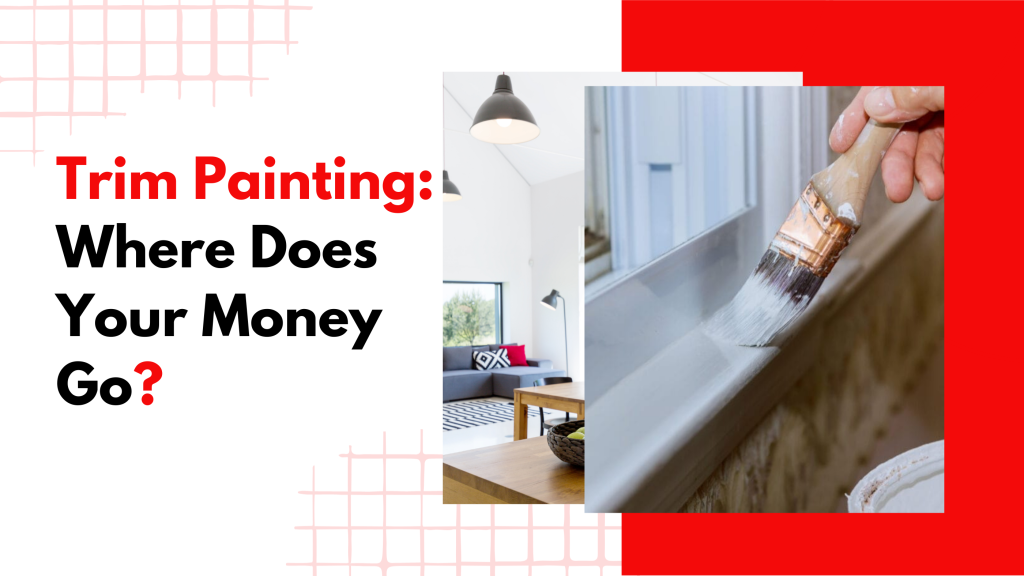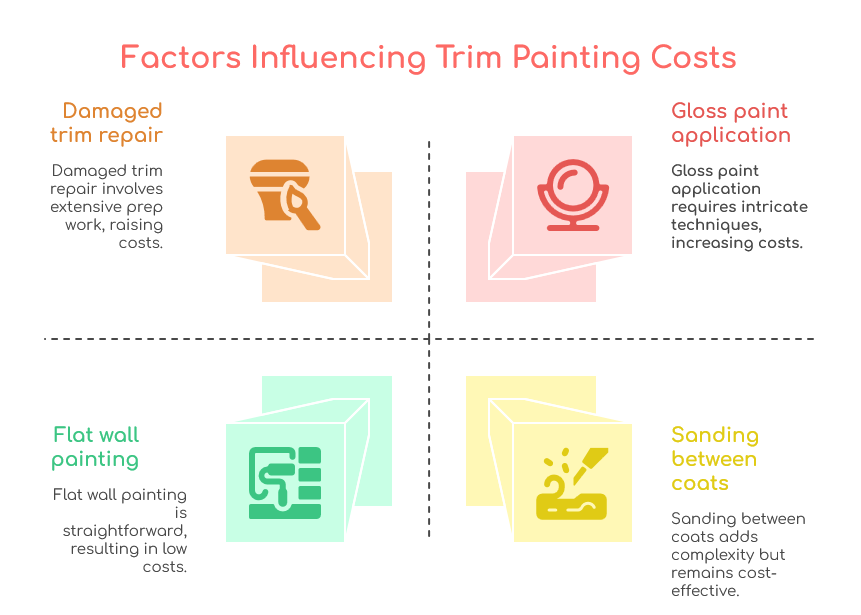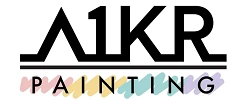
You’re painting the seams on the door, but why is it costing you way more than the walls?
Painting the trims is more expensive—why? The devil is in the details.
Think about the lengthy preparation, the intricacy of the trim and the technique that required precision—all these factors play a part in the swelling costs.
Explore all the factors that influence the trim painting costs in your home.
What Does ‘Trim’ Include?
Trim is actually an overarching category that can be reduced to different types, based on purpose, style and step-up site.
Skirting Boards
Skirting boards shield your walls and floor from moisture and kicks. It’s a decorative strip, known as “baseboards,” found in almost all homes.
Door/Window Frames
The trim that you see on your doors or windows is called casing. It functions to hide the gap between the frame and the adjacent wall, creating a clean, finished look.
Crown Moulding
Crown moulding is a decorative trim that adds sophistication and flair atop your interiour wall.
This trim is strategically placed to ensure a natural shift from the wall to the ceiling, making your home visually appealing.
Stair Rails
These are trims on your staircase, known as the banisters and handrails. It’s a stylish piece that secures the grip while you’re flaunting down the stairs.
Now, trims are usually painted with gloss or semi-gloss. This requires more precision with extra surface preparation to ensure an attractive finish.
The Real Work Behind Trim Painting
Detail-Oriented
When it comes to trim painting, one flaw starkly catches the eye, especially with high-sheen or gloss finishes. Therefore, priviness with the details is mandatory.
Needs Careful Brushwork (No Rollers)
Rollers are not designed for precision. Conversely, quality brushes provide superior control over your strokes and can reach tight spots.
Often Painted a Contrasting Colour, So Edges Must Be Crisp
Trim painting leverage colours that pop against the walls, such as pairing white and red for strong visual contrast.
With contrasting shades, the edges, where the colours intertwine, must be crisp and clean. Any sloppy brushwork will stand out and look unprofessional.
Time-Consuming Due to Corners and Awkward Angles
The awkward areas and the intricate trim designs demand for additional labour and time to prepare and paint.
What Influences the Cost?

Paint Type
The type of paint can impact the costs of your trim work.
For instance, gloss paint, often used in trim jobs, is more expensive, because it provides more protection and shine.
Trim Condition
Trims that are damaged or chipped wood that need repair require more extensive prep work, increasing labour costs.
Labour Time vs. Flat Wall Painting
When trim painting is more complex, the time and labour required to finish off the task increase.
Now, flat wall painting is the more straightforward approach. It’s low effort and quicker since you’re handling an uninterrupted surface with no architectural design.
Finishing Technique
There are trim jobs that may require sanding between coats, particularly when using high-sheen paints.
On such occasions, more hours of work are needed to accommodate the intricate finishing technique to get the job done.
Why It’s Easy to Get Wrong as a DIY Job
Trim painting might seem like a small, straightforward paint job, but in reality, it’s technically sensitive.
Let us explain the cost of painting skirting boards and trims beyond the numbers.
No Painter’s Tape or Precision
Without sure hands and painter’s tape, the results can get messy.
Clean and crisp edges require very specific trim painting techniques to achieve. Thus, if you rush the job and handle things on your own, you’ll end up with smudges and uneven lines.
Runs and Drips are Common
Trim painting involves tricky areas that might leave drips and streaks on the floor. Once dried, paints are much harder to clean.
Often Rushed or Skipped Altogether by DIYers
With your excitement, you tend to rush things and paint without proper prep work. This leaves spaces sloppy and unattractive.
Pros: Ensure It’s Done Properly the First Time
Professionals approach trim work with precision and patience. Experts do it right the first time, saving you from the headaches and money for rework.
Sydney Trim Painting Price Guide
Approximate Cost Per Metre or Room
Trim painting is usually priced per metre or room, factoring in paint type, trim condition and complexity of the job.
On average, the price range goes from $3 to $30 per metre. Some professional painters can also charge you per room, ranging between $200 and $2000, depending on the room size and job complexity.
For instance, a 3-bedroom home’s average trim quote might be around $1,500 to $5,000. The costs cover the prep work, painting and the materials used for the job.
To avoid billing surprises, use a house painting cost estimator. Better yet, ask for a detailed quote from your service provider for full transparency.
Understanding what you’re paying makes for a smart comparison to different providers.
Why Clients Trust A One Korean Painting with Detail Work

A One Korean Painting has years of experience handling interior trim. Our expert team uses specialised tools and techniques to ensure clean lines and smooth finishes that last for years.
We know all about the trim and why it matters to your home’s overall aesthetic design. We treat trims as high-impact details, approached with meticulousness and finesse.
Connect with us, and get your free, fast and accurate quote for your newest trim project.
Conclusion
Trim painting is time-consuming and labour-intensive, so plan your project right. This way, you can keep up with the costs and not stretch your budget.
Invest in the finish because that’s what the eyes are drawn to. Don’t bypass the prep work to save yourself from doing it again.
A One Korean Painting has the right expertise to handle your trim painting project and get the best results—attractive and durable against Australia’s harsh weather.
Let precise trim work define your space—get your detailed painting quote today!

